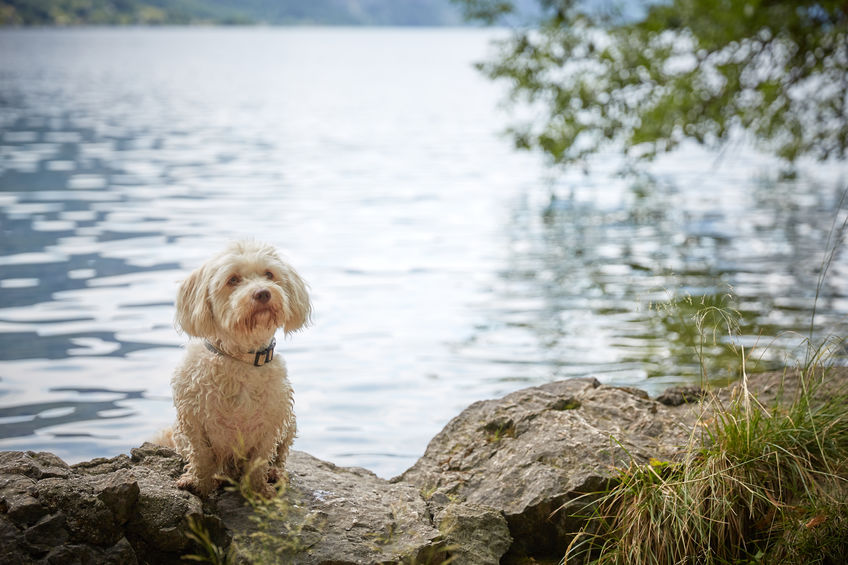One look at the Havanese dog, with all that long, luxurious hair, and the word “swim” doesn’t exactly spring to mind. In fact, if there was ever a dog that appears uniquely ill-suited for swimming, it might be the Havanese!
And yet Havanese dogs are actually quite sturdy and athletic underneath their fluffy coats, a fact which becomes slightly easier to see if you keep your pup in a short puppy clip.
Can Havanese swim? That is the question on the table in this article – let’s find out!

Can Havanese Dogs Swim?
Here, a more accurate question might be, “Do Havanese dogs like to swim?”
If you can think all the way back to your own first experience with swimming, you might remember being less than enthused the very first time you went.
And in fact, even a basic internet search for “are kids afraid to swim” will net pages upon pages of advice for parents on this very topic!
So you don’t want to base your assessment of whether your Havanese enjoys the water solely on the first few exposures. It may take some time for your pup to grasp the concept, learn the ropes, get the basic gist of the experience being offered.
After that, you will be in a much better position to decide if your dog actually enjoys swimming or is just tolerating it because you are there.
Why Teach Havanese Dogs to Swim?
Many Havanese dogs do enjoy swimming when given a chance to give it a try.
But this isn’t the most pressing reason to teach your Havanese to swim.
You don’t want your dog’s first introduction to the water to be during an emergency when swimming becomes the only survival option.
Whether you are supervising a dog or a child, water safety training is simply a must, especially if your home or common areas include a substantial water body such as a big fountain or a swimming pool that is unmonitored and could be dangerous.
Discovering that you and your dog share a love of the water is a side perk and a delightful one at that.
Should Havanese Dogs Swim?
A fully-grown adult Havanese dog typically weighs seven to 13 pounds. There are pool floats that weigh more than this!
However, being lightweight and buoyant can work in your dog’s favor, with one important exception: that long hair-like coat.
If you want to show your Havanese and are keeping the coat long, even freshwater swimming probably won’t do your dog’s coat any favors.
Swimming in chlorinated water is especially ill-advised as it can cause your dog’s hair to tangle and mat, change colors and become brittle and dry. Chlorine can also irritate your dog’s eyes, ears and skin and can cause stomach distress if swallowed.
But if your Havanese dog is a true “pet” pup and you keep your dog’s coat in the short puppy clip or a similar clip, then as long as your dog seems to be in good health overall and enjoys the experience, there is no reason why you shouldn’t teach your Havanese to swim!
Should Havanese Puppies Swim?
We don’t recommend teaching your Havanese to swim during puppyhood, by which we mean any time before your dog reaches one year old.
There are two main reasons for this:
- Accidents happen during potty training.
Potty training may continue up to one year of age. If accidents happen while your dog is on land, think how much more likely they are to happen when your nervous dog learns to swim for the first time!
- Even freshwater can have some strange stuff in it.
Chlorine and dogs is never a good mix, so if you are headed for a traditional chlorinated pool, keep it off-limits at least until your puppy grows up.
As for natural water bodies, there are plenty of potential waterborne pathogens that would love to meet your puppy’s still-developing immune system. Here again, it is just safer to wait until your dog is grown before permitting swimming.
If your puppy seems especially keen to try swimming during puppyhood, the best approach is to talk with your canine veterinarian for guidance about this.
Basic Water Safety for You and Your Havanese
These guidelines can greatly limit the risk when you and your dog are near water.
- Train your dog to wear a water safety life vest.
- Always keep your pup leashed with the leash in hand during water visits.
- Install a lockable fence around any large fountains, spas or pools that you own.
- Use a sturdy, secure pool or spa cover that won’t bow under your dog’s weight.
- Use a floating pool alarm to alert you if your dog inadvertently falls in.
- Learn pet CPR and always carry a canine emergency first aid kit.
How to Teach Havanese Dogs to Swim
The Havanese dog as a breed is very smart and sensitive to “their” people. If you’ve ever suspected that your Havanese can sense what you are thinking or feeling before you do, you are probably right!
So when it comes to training, regardless of what is being trained or how you may feel about it, there is only one training style appropriate for the Havanese breed: positive reinforcement.
Positive reinforcement is a type of operant conditioning that uses only rewards as a motivator to train new behaviors. Rewards might be treats, pats, playtime with a favorite toy, cuddles, praise or some combination thereof.
Punishment-based or “negative reinforcement” training methods for dogs are outdated and work poorly at best. This style of training works especially poorly on highly intelligent, intuitive dog breeds like the Havanese.
So you want to first consider the rewards that your Havanese will find especially motivating and plan to use those as you train your dog to learn to obey basic water/pool safety commands and to swim.
Let’s take a closer look at what Havanese breeders and experts recommend for basic training for each category.
Basic water safety commands.
These basic water safety commands will come in handy as additions to basic canine obedience training.
- Water area entry command: teach your dog not to enter the water area until you give the command.
- Water entry command: teach your dog not to enter the water until you give the command (or until you carry them in yourself).
- Water exit command: teach your dog exactly where the exit point(s) is/are and how to access and use them. Also, teach the command to exit the water.
- Water area exit command: teach your dog where the exit from the pool/water area is and to go to it when you give the command.
Swim training.
For your pup’s safety, never train your dog to swim until at least 30 to 60 minutes after their last meal or big drink of water.
Remember that all dogs (heck, all life forms) will start doing a form of paddling if suddenly dropped into a body of water! This is NOT the same as swimming. You want to watch very closely for signs of fatigue or distress – remove your dog from the water at once if you see either.
The water entry command should always be issued before you get into the pool together. Start off very close to the water exit point. When your dog first starts to paddle in the water, place your hand underneath the belly to offer support and reassurance.
As your Havanese gets stronger and more confident, you can move a little further out from the exit point to practice.
Always keep initial training sessions short and sweet and make sure every training session is packed – literally packed – with praise and pats. Save food treat rewards for after you have finished the swim lesson for the day.
Canines and chlorine.
While your dog may try to sneak a slurp, do your best to ensure your Havanese does not ingest any chlorinated water. Rinse your dog immediately and thoroughly with fresh water after swimming.
Have a bowl of fresh drinking water available at all times and offer it frequently between swims to be sure your dog doesn’t feel tempted to drink chlorinated water.
Watch carefully after swimming for signs the chlorine may be irritating to your dog’s eyes, ears or skin.
Can Havanese Swim?
Answering the question “Can Havanese dogs swim?” is not quite so simple as it appears. Just like people, dogs have their own preferences. Just because your neighbor’s Havanese hates the water doesn’t mean your Havanese won’t love to swim!
The key is to do your own homework to find out what your Havanese dog enjoys. By keeping training sessions short, sweet and packed with praise, your Havanese is more likely to view swimming as a fun activity you can share.




